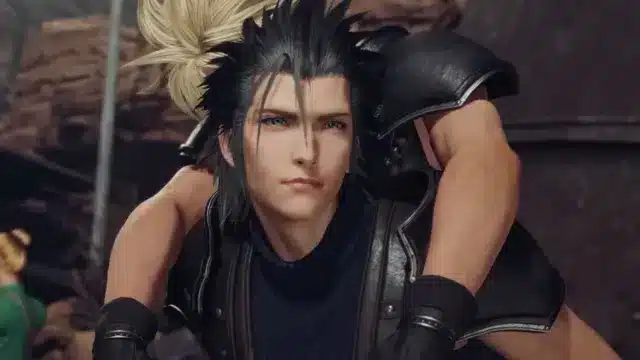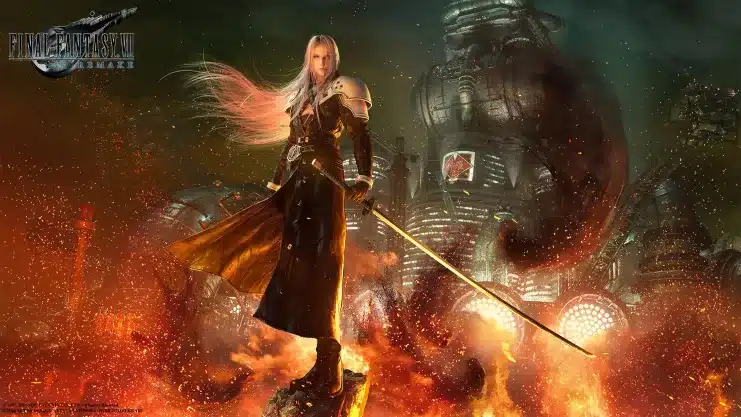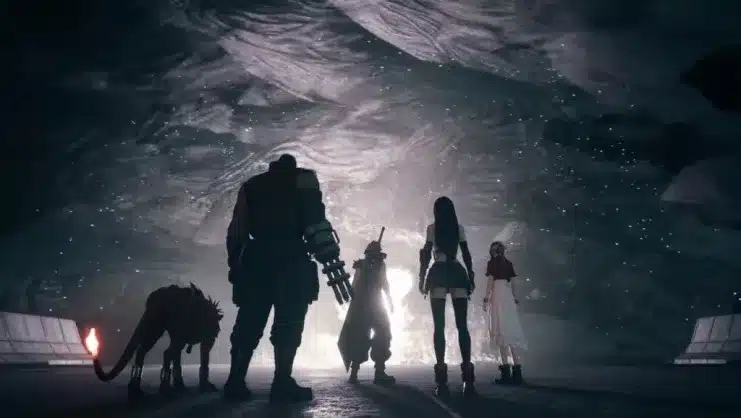

A critical revision of the narrative cracks of the main theories of Final Fantasy VII: from Multiversos to Gaia cycles, through the reminiscences of Evangelion and Sequel with memory
I. Introduction
The Final Fantasy VII remake trilogy generated an avalanche of interpretations by fans, from the theories on the multiverse to type the reconstructions Reconstruction of evangelion. This explosion of creativity, although exciting, began to extend before the narrative bases established by the game.
The goal of this article is not to invalidate the creativity of the fans of Final Fantasy VIIBut to carefully examine the weak points, contradictions and empty of the most popular theories on remake and rebirth. When analyzing key events, symbolic elements, declarations of Kazushige Nojima And internal inconsistencies, how many interpretations are evident, far from clarifying the panorama, they transform it even more confused.


II. The theory of parallel temporal lines: a problem of narrative synchronization
One of the most popular theories is that there are multiple temporal lines. The world in which Zack survive and return to Midgar It is raised as a different line from central history. However, this theory presents evident structural errors:
After reaching Midgar, Zack crosses with a Biggs who has knowledge of Cloudwhich further complicates the consistency of that temporal line. If it is a separate line, at what point the cloud has joined Avalanche If you have always been with Zack?
During his tour, Zack finds Marlenewho seems to recognize Air In a context that occurs during the collapse of the pillar of sector 7 – a fact that temporarily does not correspond to its arrival since this happens much later. How is that connection possible if they are different lines and unbelieved events?




These points suggest that they are not independent temporal lines, but on echoes, interference or spiritual resonances within the same level of reality, in which time behaves symbolically, not physical.
III. The multiverse: a big name with small bases
At first glance, talking about a multiverse seems to solve many narrative problems. However, in the context of Remake Final Fantasy VIIThis idea also falls:
The narration of the game indicates that the divergent “worlds” are trained inside the planet, not in an external universe. What happens then with the rest of the world beyond Gaia? Does Gaia alone have the multiverse?
These worlds “return to the planet” after being consumed, which contradicts the classic notion of independent parallel universes.
They are never duplicated interacting. Instead, Aeris and Cloud seem to “take the body” of their counterparts, as if they were projections of consciousness and not physical duplicates.




This theory is charged with the same mistakes as that of the temporal lines, also adding an ontological inconsistency: if these are real and physical worlds, they should not collapse as if they were mental or energy constructions.
IV. The Cyclic Gaia: a cycle that is not supported
Starting from ideas such as reincarnation on a planetary scale, This theory suggests that Gaia restarts its own story in cycles, probably as a form of protection or self -regulation (A defense mechanism).
But this raises questions to which the narrative does not answer:
When Gaia decides to restart the cycle? What was the trigger?
If the cycle is a punishment or a correction, why do important events continue to occur? Shouldn’t the restart avoid errors?
JenovaAs an alien entity, it is not part of Gaia. How is it possible that its appearance is repeated in every cycle of history if it comes from space?
The same goes for GiA tribe also of extraterrestrial origin. His constant presence in history would not make sense within a closed cycle controlled by Gaia.
And if Gaia is constantly restarting, why does Sephiroth never win? Are you condemned to losing always because Gaia prevents him?




Although the hypothesis of the Gaia cycle tries to give explanations to different inconsistencies, thus generates new questions and questioning the individual decision capacity of the characters, which seem to be subject to an automatic planetary script.
V. The theory of direct sequel: temporary and narrative contradictions
Another interpretation is that the remake of Final Fantasy VII and the rebirth of Final Fantasy VII are direct sequences of the original game and that Sephiroth has moved his conscience from the children of Advent to avoid his defeat and alter the course of the facts.
But this theory weakens in different points:
If Sephiroth wants to change destiny, why does it continue to allow the important events of the original to almost exactly occur?
For example, allow Aeris to invoke Sacred Before killing her, repeating his fatal error. I also underestimate it again (literally says before starting the final combat Final Fantasy VII Rebirth), Something that doesn’t make sense if you already know what you can do.


Furthermore, if your consciousness has evolved so much, because it did not intervene in the key moments of the past, how to prevent cloud from defeating it Nibelheim?
The direct sequel is not reflected in the action.
You. Riaphonlation or senior theory: evangelion seriously applied
Influenced by the narrative approach of Evangelion’s reconstruction, this theory claims that the remake represents a cycle reinterpreted rather than a direct continuation or a restart and that some characters – such as Aeris and Sephiroth – maintain the memory of other versions of the world or a previous cycle.
Despite its charm, this theory falls on different fronts:
In Evangelion, the visual indications of a cycle – such as the red tinted red or the blood on the moon, the remains of past events – are evident from the first film. On the contrary, The remake does not offer visual signals that indicate that we are facing a repetition of the original story from a new starting point.
In Evangelion, the cycle breaks abruptly in the second film. In Final Fantasy VII Remake and Final Fantasy VII Rebirth, the important events of the original continue to occur without important deviations.




If Sephiroth has moved his consciousness to the past:
Why did not prevent the invocation of the sacred?
Because your conscience has not moved when the cloud mentally resumes with the help of Tifa in At the same timeKey event for your defeat?
If you really have access to time, why don’t Sephiroth returns directly to the time of Nibelheim to prevent the defeat at the hands of Cloud from the beginning?
And if Sephiroth can try again and again to change the result every time he fails, his role as bad loses strength, becoming more a repetitive and trapped figure in a cycle than in an unpredictable threat.




The problem of this theory is that it tries to adapt to the remake Final Fantasy VII within the symbolic structure of another franchise without the elements adapt. Evangelion and Final Fantasy VII share existential themes, but not a narrative structure.
VII. The Echoes and the Canon: Guardians or Saboteators?
Some theories postulate that the echoes are “Canon Guardians” that prevent the story from deviating from the original game. But this also presents paradoxes:
If the echoes protect the tax, why steal the memories of Aeris, one of the few capable of avoiding disaster?
Why should the planet allow someone dangerous as Sephiroth to take the black material only by fulfilling a consolidated canon?
Why would the canonical road seem to be the only one in which the planet can survive?




These contradictions could suggest that the echoes are not really correctors in history, they act more as unconscious forces than as aware guardians.
VIII. Jung, Yogacharra and inspired the truth of the Guon
Kazushige Nojima, the main screenwriter of the Remake Final Fantasy VII trilogy, said in the interviews that He was inspired by the analytical psychology of Carl Jung and the yogacara philosophy of Buddhism.
Both currents speak of reality as a construction of the mind, the collective unconscious and the subjective perception of the world. In other words, What we see in the remake of Final Fantasy VII are not parallel physical universes, but internal realities that manifest themselves through the soul, memory and desire.




In Jung, concepts such as shadow, collective unconscious and the identification process are central. Characters such as Sephiroth or Cloud reflect repressed parts of themselves.
According to Yogachara Philosophical School, everything we perceive is generated by the mind. The outside world is not independent or objective, but an illusory construction based on karma, memory and flow of consciousness.


These conceptions are in conflict with approaches such as temporal trips or multivers understood as specific physical structures. Rather, they underline that everything that happens in the remake of Final Fantasy VII is a spiritual and emotional metaphor on the reconstruction of being, not a series of literal events that occur in alternative space airplanes.
IX. So … what does this trilogy tell us?
All these theories have something in common: they try to rationalize what the remake and the rebirth build from emotion, symbolic and spiritual.
There is no strong tests of multivers, temporal lines or physical planetary cycles.
What we see is a narrative that uses the past as an echo, mirror and resonance, not as a literal material to be rewritten.
The divergent “realities” collapse because they are not real in a physical sense, but the projections of the unconscious of the planet and the characters.


More than a rewriting of the past or a literal sequel to the original, the trilogy of remake final fantasy VII seems to focus on an emotional and symbolic exploration of the same. It is not that “what happened” is changed, but that a new story is given to a new story that takes as a reference to the emotional experience of the player with the original. From this perspective, the important thing is not that the events of the past have literally happened in this narrative world, but how the characters and the player now face a reinterpreted version of those key moments.
This reading adapts to the declarations of the screenwriter Kazushige Nojima, who mentioned it The history of the trilogy is influenced by the thought of Carl Jung and Yogachara Buddhist School, both focused on internal transformation, perception and integration of the psyche rather than an objective chronology of the facts.
The trilogy seems to focus not on the change of what happened, but on the change of how we are emotionally relating to what happened. It is not a question of saving Aeris, but of understanding his sacrifice from a new human dimension.


X. Conclusion: When the echo of the past becomes inclusive
The remake of Final Fantasy VII and the rebirth of Final Fantasy VII do not really try to reconstruct or correct what happened in the original game. They are tools to explore trauma, loss, repentance and redemption in a new symbolic key.
The interpretations that resort to temporary journey or parallel realities as the main explanations neglect the essential: Final Fantasy VII is not telling a classic story of science fiction, but a spiritual and psychological exploration on emotions, identity and memory.


Next article: what are the echoes?
In the following article we will thoroughly explore the mysterious echoes: are they manifestations of the planet? Canon Guardians? Reflections of the collective unconscious?
Prepare to enter the metaphysical nature of the echoes and their role in the narration of the Remake Final Fantasy VII trilogy.
Final note: this article is an interpretative analysis and is part of an entertainment and narrative exploration project. Until the trilogy is complete, nothing is written in stone. What is clear is that there is much more to discover.
If you want to know more about the Final Fantasy VII remake trilogy, click on the following titles
Final Fantasy 7 Complete on Switch 2? The director drops the bomb
The enigma of the Masamune in Final Fantasy 7 has an official explanation

